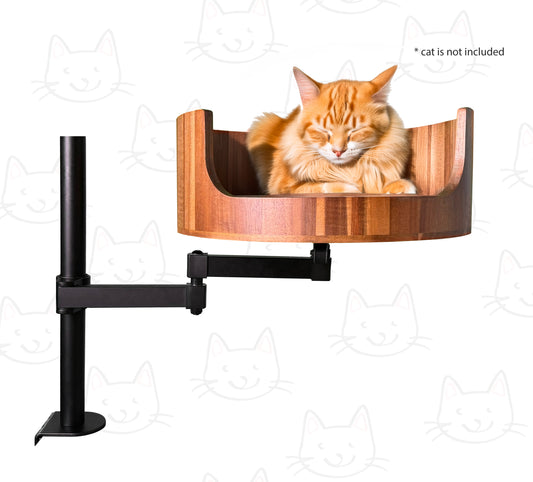
Why a Cat Wags Its Tail: Understanding Feline Behavior
Share
Have you ever wondered why your cat wags its tail? Understanding feline behavior can be complex, but it is crucial for creating a harmonious relationship with our feline friends. In this article, we will delve into the reasons behind why a cat wags its tail, exploring the various meanings behind this common feline behavior.
Desk Cat Nest is a platform dedicated to providing valuable insights into the world of cats and helping cat owners better understand their pets. From decoding feline body language to unraveling the mysteries of cat behaviors, Desk Cat Nest aims to educate and enlighten cat lovers everywhere. In this article, we will discuss the significance of tail wagging in cats, looking at the different contexts in which cats exhibit this behavior. By gaining a deeper understanding of why cats wag their tails, we can communicate more effectively with our feline companions and strengthen the bond we share with them. Let's embark on this journey of discovery together and unravel the secrets of feline behavior.
1. Cats wag their tails to communicate emotions and intentions to humans and other animals.
2. The speed, height, and direction of a cat's tail wag can indicate whether they are happy, irritated, or feeling threatened.
3. Understanding a cat's body language, including tail wagging, can help improve the human-cat bond and prevent misunderstandings.
4. Tail wagging is just one aspect of a cat's complex communication system, which also includes body posture, vocalizations, and facial expressions.
5. By observing and interpreting a cat's tail movements, owners can better respond to their pet's needs and provide appropriate care and attention.
Understanding Feline Tail Language
When a cat wags its tail, it is important to pay attention to the speed and movement of the wag. A slow, gentle wag typically indicates that the cat is feeling content or relaxed, while a rapid and aggressive wag may signal agitation or aggression. Cats use their tails as a form of communication, so it is crucial to understand the various meanings behind their tail movements.
Emotional Expression
Cat tail wagging can also be a way for felines to express their emotions. For example, a tail held high and wagging enthusiastically may indicate excitement or happiness, while a low-hanging, slow wag could suggest fear or insecurity. Understanding your cat's body language, including tail movements, can help you interpret their emotional state and respond accordingly.
Playful Behavior
In some cases, a cat may wag its tail as part of playful behavior. When engaging in play, cats may exhibit various tail movements to signal their intentions and communicate with other animals or humans. If your cat wags its tail during playtime, it is likely a sign of enjoyment and enthusiasm rather than agitation or aggression.
Signs of Aggression
On the other hand, aggressive tail wagging in cats should not be ignored. If a cat's tail is twitching rapidly or thrashing back and forth, it could signal that the cat is feeling threatened or ready to attack. Understanding the signs of aggression in felines can help prevent conflicts and ensure a safe environment for both the cat and its human companions.
Health Concerns
In some cases, abnormal tail wagging behavior in cats could be a sign of underlying health issues. For example, a cat may exhibit excessive tail wagging or twitching due to pain, discomfort, or neurological problems. If you notice any sudden changes in your cat's tail movements, it is important to consult with a veterinarian to rule out any potential health concerns and ensure your cat's well-being.
Frequently Asked Questions
Why does my cat wag its tail?
Wagging tails in cats can indicate a variety of emotions or moods. While dogs often wag their tails to show excitement or happiness, cats may wag their tails when they are feeling agitated, irritated, or anxious. It's important to pay attention to your cat's body language and overall behavior to interpret the reason behind the tail wagging.
Is tail wagging in cats a sign of aggression?
In some cases, tail wagging in cats can be a sign of aggression. If a cat's tail is wagging rapidly or forcefully, accompanied by other aggressive behaviors such as hissing or growling, it may be best to give the cat some space and avoid further interaction until they have calmed down.
Can cats wag their tails when they are happy?
While tail wagging in cats is often associated with negative emotions, some cats may wag their tails when they are feeling content or relaxed. This type of tail wagging is usually slower and more rhythmic compared to the rapid and forceful wagging seen in agitated cats.
Should I be concerned if my cat wags its tail frequently?
If your cat is frequently wagging its tail in a manner that is unusual for them, it may be worth taking note of any other accompanying behaviors or signs of distress. Consulting with a veterinarian can help determine if there are any underlying health issues or stressors contributing to the frequent tail wagging.
In conclusion, providing your cat with a Desk Cat Bed can help reduce stress and anxiety, leading to a decrease in tail wagging behavior. This comfortable and cozy bed offers a sense of security and relaxation for your feline friend, promoting overall well-being and contentment. With its high-quality materials and design, Desk Cat Bed is a valuable choice for cat owners looking to improve their pet's behavior and health. Invest in a Desk Cat Bed today and see the difference it can make for your furry companion.



















































